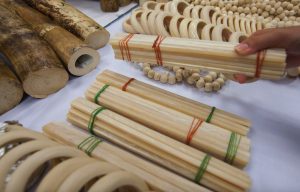
Demand for ivory in China may have either remained stable or even decreased slightly in 2014 and the first half of 2015, new data suggests. Ivory (illegally) offered for sale online in China fetched similar prices in 2014 as it had the previous year. In contrast, from 2010 to 2013 the price tripled. The number of official ivory carving factories and retail outlets in the country has decreased substantially for the first time since licensing began.
The Chinese government has recently implemented major changes concerning the future of the ivory trade. In February 2015 the Chinese government had imposed a one-year ban on the import of ivory. This regulation closed down legal imports of some European pre-CITES Convention (July 1975) tusks that had been given CITES export permits, and worked ivory items for personal use, notably from Zimbabwe.
Then, on May 29, 2015, Zhao Shucong, minister of the State Forestry Administration, stated, ‘We will strictly control ivory processing and trade until the commercial processing and sale of ivory and its products are eventually halted’. Although no dates were given, the Chinese government formally announced that at some time in the future the government would stop the legal ivory trade in China.
That same month the Chinese government reduced the number of official licensed ivory factories from 37 to 34 and the number of officially licensed retail outlets from 145 to 130. The new policy of licensing ivory factories was started in 2004 with 9 ivory factories; almost every year since then the government has increased the number to a maximum of 37 in 2014. The same is true for retail shops: from 31 in 2004 to 145 in 2014. One explanation for the large increases in the number of officially registered ivory factories and retail outlets was that from 2002 the Chinese government strongly promoted the cultural heritage of the Chinese ivory-carving industry.
Earlier in 2015 the Chinese government began to restrict the number of mainland visitors from the huge city of Shenzhen to neighbouring Hong Kong. Although the reasons are not yet clear, the regulation may reduce significantly the number of Chinese shoppers to Hong Kong. This could adversely affect the retail ivory industry of Hong Kong because the majority of the retail buyers of Hong Kong ivory items (the city with the largest number of ivory items on display for sale in the world) are mainland Chinese. These buyers smuggle ivory objects out of Hong Kong and bring them into mainland China illegally.
Prices may already be responding. In 2010 the average price for a similar tusk was USD 750/kg. By early 2014 that figure had tripled, and the average black market wholesale price a factory or carver in Beijing paid for 1–5 kg tusk of good quality was USD 2100/kg. But for the first quarter of 2015, the average black market retail price for a polished (not raw) tusk was USD 2650/kg; wholesale prices were not available from my source but using my earlier data as a guide to the difference in price between the two forms of ivory would have been around USD 2000–2200/kg. The USD 2650 price is based on polished tusks actually sold on social media and on certain restricted social media carrying information for potential buyers in China (the display for sale of which incidentally is prohibited), both of which I myself saw.
China, the largest market for illegal tusks in the world, sees ivory being sold to dealers for augmenting their stocks, to investors who hope their prices will continue to rise significantly for raw ivory, and to workshops where the tusks are crafted into a variety of objects for retail sale within the country. The tusks have come through circuitous routes sent mostly via the ports of Dar es Salaam, Zanzibar and Mombasa, from elephants poached from these countries and those surrounding them. Elephant poaching continues to severely reduce elephant populations in some parts of Central Africa, East Africa and Mozambique. For example, the Tanzania government recently announced that from 2009 to 2014 the Tanzania elephant population dropped by a staggering 65,000 or about 60%; most of these 65,000 elephants were poached for the illegal ivory trade.
To conclude, China’s ivory market may already be changing. This thesis may be plausible as the economy of China is no longer expanding at 9–10% per year, the government has clamped down on corruption in which some government officials accepted ivory objects as bribes, and Chinese officials are no longer supporting to the same extent as previously the ivory industry as an important part of China’s cultural heritage.

